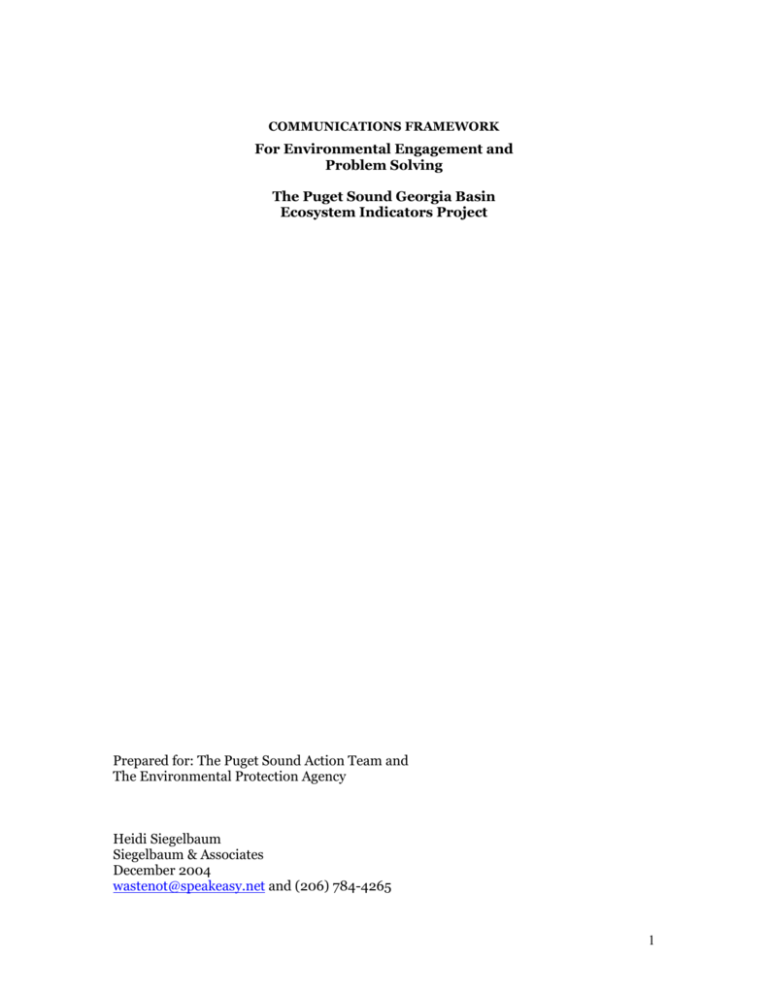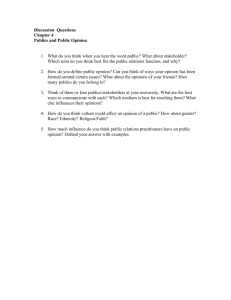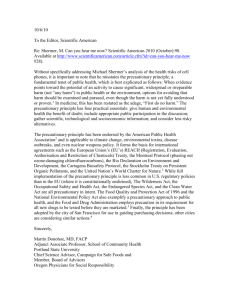communications framework - American Cetacean Society
advertisement

COMMUNICATIONS FRAMEWORK For Environmental Engagement and Problem Solving The Puget Sound Georgia Basin Ecosystem Indicators Project Prepared for: The Puget Sound Action Team and The Environmental Protection Agency Heidi Siegelbaum Siegelbaum & Associates December 2004 wastenot@speakeasy.net and (206) 784-4265 1 1.0 Background and Use of This Document This communication framework was developed in connection with the Communications Strategy for the Puget Sound Georgia Basin Ecosystem Indicators Report, Phase II. It should be used: (a) As a guidance document to help inform and refine the approach to developing and using these transboundary indicators, and (b) As a guidance document for all environmental work undertaken by government agencies, non-profits and community groups. 2.o Context and Approach This section describes the general philosophy and approach that, through experience, has been proven effective in government agency-external relationships. It is intended to provide context not only for agency and allied partner’s work, but as a way of communicating the complex, interlocking issues that underscore indicator development and use. These issues are relevant to all environmental agency work where principles of risk communication provide the basic tenets for our work. Risk communication is, in turn, based on principles of cognitive and behavioral psychology. 2.1 Positive Approaches to the External World Polarity tends to characterize environmental issues. “Environmentalists said,” “businesses think regulations are making the state uncompetitive,” and so on. There are certain basic rules of thumb by which public agencies can engage their various publics more productively and help avoid destructive, polarizing approaches. It’s hard to be gracious when we are falling into the terrestrial abyss of despair, but we have to try.1 Key concepts in regaining public confidence are trust and respect. To regain trust, communications and approach must be fair, open and honest. Fairness means the ability to participate in ways that work for outside people, in which people get the same information at the same time, we provide a safe physical and intellectual environment for the exchange of ideas (which shouldn’t always be our offices between 8 and 5), and make sure the people who are affected by our decisions help make those decisions. The authors query “Would you play in a game in which the rules were unclear? Where the other guys used questionable tactics? Where you don’t trust the players? In a game that is simply perceived as unfair?” Being open means listening (and hearing for that matter, a different concept). Supreme Court Judge Stephen Breyer in his confirmation hearing stated “[l]istening gives dignity to the person being listened to.” People must understand their role as advisory versus governing (when we seek outside opinions for measure/indicator development), the process must be straightforward and understandable, and the agency must be willing and able to accommodate public process and be honest if it cannot do so because of some political, monetary or other constraining reason. Honesty, the heart of integrity, is a key element of respect… it is a step along the path to trust. Harvard Professor Sara Lawrence-Lightfoot had a different definition of respect, one derived not from deference but from equality, empathy and connections of all kinds of relationships, even those often seen as unequal… The image is a circle. 2 Faast and Simon-Brown noted the unspoken obvious. “Let’s admit it. Some of us don’t like the public process aspects of our jobs!... Some of us got into the business to ‘get away from people.’” The lesson here is knowing who to send as a spokesperson to interact with the public. The lessons they unearthed in their extensive research and on-the-ground experience include these observations: 1. Constructive conflict leads to innovative solutions (read: don’t demand that everyone agree); 2. People want to be involved in meaningful conversations which lead to good decision making (read: communication must be open, early and inclusive); 3. People want to be heard (read: avoid dismissive ness); 4. People who are involved develop ownership for the idea (read: we need to make more of our decisions with people and communities rather than for them); 5. People have a stake in the future of public resources. “Public mistrust is borne often of fundamentally unethical actions exhibited by agencies and individuals that have preceded us. We can’t effectively apologize to our publics for the past; we can only establish our own credibility for the future.” 2.2 Using Risk Communication Principles Risk communication underscores our work and is defined as a discussion about risk types and levels and about methods for managing risks. It is an interactive process of information exchange and opinion among individuals, groups and institutions. 2 Plainly, we are in the business of communicating to our publics about risk to humans and the ecosystem of which they are a part. Of the 47 known factors that influence the perception of risk, issues such as control, benefit and whether a risk is voluntarily assumed rank the highest. 3 Attitudes about how science and technology are controlled are better predictors of risk levels than are the cost-benefit considerations, judgments about effects or concerns about how science and technology are used. 4 Based on research conducted by EPA’s Office of Research and Development, some of the most effective ways to inform the public about environmental risk are: 1. 2. 3. 4. 5. 6. 7. Establishing a web site that displays a variety of data visualization tools (maps, colorcoded charts) Arranging for local news media to present our information Establishing a telephone hotline Developing a collection of printed materials Interactive kiosks at strategic locations Giving presentations to local officials and others; and Incorporating information into school science curriculum 5 Cognitive and behavioral responses are part of risk communication theory. In essence, we are communicating information regarding the risks to ecosystems, organisms and ourselves. In sum, the tendency to underestimate risks is based on several theories, among them: (1) risk underestimation to get on with one’s life; (2) psychological stress theory and emotion-focused coping as a response to threats perceived as uncontrollable. A second category includes cognitive and perceptual shortcuts (heuristics, or rules of thumb), biases and errors. These include 3 gambler’s fallacy (thinking that if a disaster occurs, the likelihood of one occurring soon thereafter is slim). In addition, while processing information, people use shortcuts, tricks and heuristics. This in turn is premised on the theory of bounded rationality—the idea that humans could not possibly be rational because of the large number of decisions they must make in a limited time, the large quantity of information from the outside world to process and the limited capabilities of the human mind. 6 2.3 Writing Vividly The first cardinal rule is to know something about the targeted audience you are writing for before one finger hits the keyboard. The second is to know when you can’t write and how to find someone who can. Many a talented scientist is misused when asked to translate raw data into other oriented written or visual materials. Sometimes the results are not ideal when the objective is to develop simple to understand and use information that contains consistent messages. Make every attempt to make writing for external publics a group exercise in which technical writers, communications specialists, media specialists, and social scientists are used to take that data and make it the most useful for the target audience. 1. Avoid jargon, acronyms and passive voice. 2. Be clear and try to balance clarity with accuracy. Accuracy may have to be illustrated in more detailed technical documents. 3. Write relevantly, or make sure the information applies specifically to the reader (individuating information). 4. Tell a story that links indicators: Rather than artificially separating out the indicators, try to link most of them by showing (example) how impervious surfaces and chemical use affects surface water quality, salmon production, Orca food supplies and toxins in the marine food chain. 5. Where possible, include links to economic results and community issues. 6. Have levels of information- graphic and general information with links to more detailed information. 7 (Communicating Env Indicators- NJ research) Practical tips for messaging: Framing the Probability of Hazards For very remote threats (climate change), you need to shorten people’s time frames so they can see that the probability of the risk occurring is higher than they think in their lifetimes. The probability of a hazard occurring versus its severity is what makes people take precautionary action. Connecting with Reader Values and Evoking a Sense of Control Ensure you are connecting with a personal value of the listener/reader. If the reader does not see something they value as being threatened, they just won’t care and hence, will not take action. Let people know that the solution to the problem is possible and they are capable of controlling that risk. If an individual perceives that they have no control over the risk, they will revert to emotionfocused coping, including avoidance, wishful thinking, religious faith, and fatalism (this is a 4 crucial concept called perceived self efficacy and is one of the mainstays of behavioral change). Avoid making the reader/listener feel helpless, a state that can be induced by overly negative issue portrayal with no way out (what you can do). The state of helplessness- a person’s perceived inability to control key parts of his/her environment- is unpleasant and can lead to prolonged states of learned helplessness. The solution and the control must be laid out clearly and in easily understood terms. Frame issues so that people know what they are LOSING rather than gaining, by not taking the action you want them to (based on prospect theory, whose major tenet is that people are disproportionately impacted by an outcome that is certain versus one that is uncertain) 8 (Environmental Problems and Human Behavior: Gerald Gardner and Paul Stern: ISBN 0-20515605-3; Chapter 9). 2.4 Visual Display 1. On web sites, use color graphics but in print, consider black and white since it will be copied and colors may not copy well. 2. Graphics and font size should be consistent because larger graphics have been misinterpreted as being more important. 3. Unclutter graphics regarding size, titles, labels, axes and scale. 2.5 Beyond Information to Behavior Change The second step in good writing is to understand that information flow alone-- in the form of indicators, data, reports and web sites directed to our audiences--rarely changes behavior. Human behavioral change, whether individual or organizational, is a precursor to environmental change. The Perceptions of Science Behavioral change and perceptions of science is a complex business. Consider the following which sets forth the way in which people use scientific findings: The trimodal model, a communication model, is based on selective strategies used by people in using scientific findings: 1. 2. 3. Different recipients select different offers of scientific interpretations of reality, or subjective assessments by potential users. This is decisive for the nature and scope of knowledge adopted. The information picked up by the recipient is then interpreted according to the person’s personal knowledge and experience, as well as to their existing values and attitudes (internal context). For the recipients, the situational and social settings define their environment and therefore, determine the selection of information and the following interpretation. Depending on the specific object of innovation, the social and communicative structure of the system either promotes or inhibits the diffusion of innovation in the system. So, to recap, there are several filters through which scientific information will flow: First, the structural and social setting; second, the subjective interpretation of the recipient; and third, the personal knowledge/experience, as well as the existing values and attitudes of the recipient. 9 5 The Iterative Process and Feedback Loops 1. Behavior is mediated through cognitions: what we know and think affects how we act Knowledge is NOT sufficient to produce behavior change. Perceptions, motivations, skills and factors in the social environment also play important roles. 2. Interpersonal (within one’s self): knowledge, attitudes, beliefs, motivation, self-concept, developmental history, past experience, skills and behavior. Also consider: (a) readiness; (b) perceptions of threat (people respond to probability more than severity) and the accompanying appraisal of a recommended behavior for preventing or managing the problem; (c) processes by which people take in and use information in their decisionmaking. 10 Behavior Change As a Process Pre-contemplation (action by us: increase awareness of need to do something) Contemplation (action: motivate and encourage) Decision/determination (action: assist in developing action plans, set goals) Action (action: assist with feedback and reinforcement) Maintenance: these are all circular patterns where people can enter and exit at any point (action: assist in coping, reminders, find alternatives) ASK your audiences: (1) are you interested in x? (2) Thinking about x? (3) Ready to plan …? (4) In the process of….? (5) Trying to maintain..? Then tailor your messages and strategies to the appropriate stage people are in (or you think they are in). Influences on People’s Readiness to Change According to the US Public Health Service (Hochbaum, Rosenstock, Levanthal and Kegeles) the following factors influences people’s readiness to act, and is based on four constructs: (1) perceived susceptibility (probability); (2) perceived severity; (3) perceived benefits; (4) perceived barriers; (5) cues to action that would activate the readiness and stimulate overt behavior; and (6) self-efficacy or one’s confidence in the ability to successfully perform an action. The Communication Initiative: Summaries of Change Theories and Models The likelihood of performing a given behavior is determined by: (1) intentions (2) habits; and (3) facilitating factors: Intentions, in turn, are a function of (1) outcome expectancies (or perceived consequences of performing the behavior); (2) social influences (including norms, roles and self concept) and (3) emotions. The variables underlying behavioral performance are: Positive intention= commitment Remove barriers Person has the skills (under different conditions- this can be merely the perception that you have the skills to make a difference) Benefit exceeds cost Norms support the behavior Consistent with self image Emotional reaction is positive 11 Individual practices are substantially the result of conformity to the expectations of others. We have to ask how do groups change their behavior? 6 2.6 Advancing the Precautionary Principle The precautionary principle is a policy framework that, in its essence, means to err on the side of caution. In January 2004, a group of non-profit, academic, private sector and children’s health organizations developed a policy framework for adopting the precautionary principle in the City of Seattle and King County’s Comprehensive Plan. This working group recommended that the precautionary principle be applied when we suspect our actions may pose a threat to human or ecological health, and when scientific uncertainty might otherwise keep us from taking action to prevent harm. When agencies are forced into a position of having to prove risk, rather than shifting the burden to the proponent to show no adverse risk, they become caught in a perpetual science war of thresholds. The result is that we manage risk rather than prevent it, the latter a well known and effective approach to reducing adverse environmental and human health and financial impacts. The precautionary principle includes: 1. 2. 3. 4. 5. Taking anticipatory action to prevent harm in the face of scientific uncertainty Exploring alternatives, including the alternative of “no action” Considering the full cost of environmental and health impacts over time Increasing public participation in decision-making Shifting responsibility for providing evidence to proponents of an activity When we communicate about environmental and human health risk, an external discussion should ensue about the complexities of risk and options for action. This discussion may also help our publics to appreciate the gray area of environmental management and use the indicators more narrowly. 12 Notes 1. A Social Ethic for Fish and Wildlife Science, FAAST, Tony and SIMON-BROWN, Viviane. 1999. Human Dimensions of Wildlife. Fall, Vol 4, No3. 2. U.S. Public Health Service 3. Seven Cardinal Rules of Risk Communication. Drafted by Vincent T. Covello and Frederick H. Allen; EPA, April 1988, OPA-87-020 4. Food Safety and the Consumer- Perils of Poor Communication. Food Safety Network. http://www.foodsafetynetwork.ca/risk 5. Risk Communication in Action- Environmental Case Studies. EPA-625/R02/011. September 2002, EPA Office of Research and Development 6. Environmental Problems and Human Behavior. Stern, Gerald T. and Stern, Paul C. Allyn and Bacon Press, at 219. ISBN 0-205-15605-3 7. ] Communicating Environmental Indicators: Phase II Research Results. Ginger Gibson, Caron Chess, Branden Johnson and Stephanie Carey. Center for Environmental Communication, Rutgers University. http://www.aesop.rutgers.edu/~cec 8. Environmental Problems and Human Behavior, Chapter 9 7 9. Putting Science into Practice: diffusion of scientific knowledge exemplified by the Austrian ‘Research Initiative Against Forest Decline.’ Michael Pergernig, Forest Policy and Economics 1 (2000) 265-176 10. National Institutes of Health: http://www.oc.nci.nih.gov/services/theory_at_glance/Part-2.htm 11. Social Marketing, Improving the Quality of Life. Kotler, Leo; Roberto, Ned and Lee, Nancy. Sage Publications, 2002. ISBN 0-7619-2434-5) 12. A Policy Framework for Adopting the Precautionary Principle. American Lung Association of Washington. Robin Evans-Agnew; robin@alaw.org). 8








